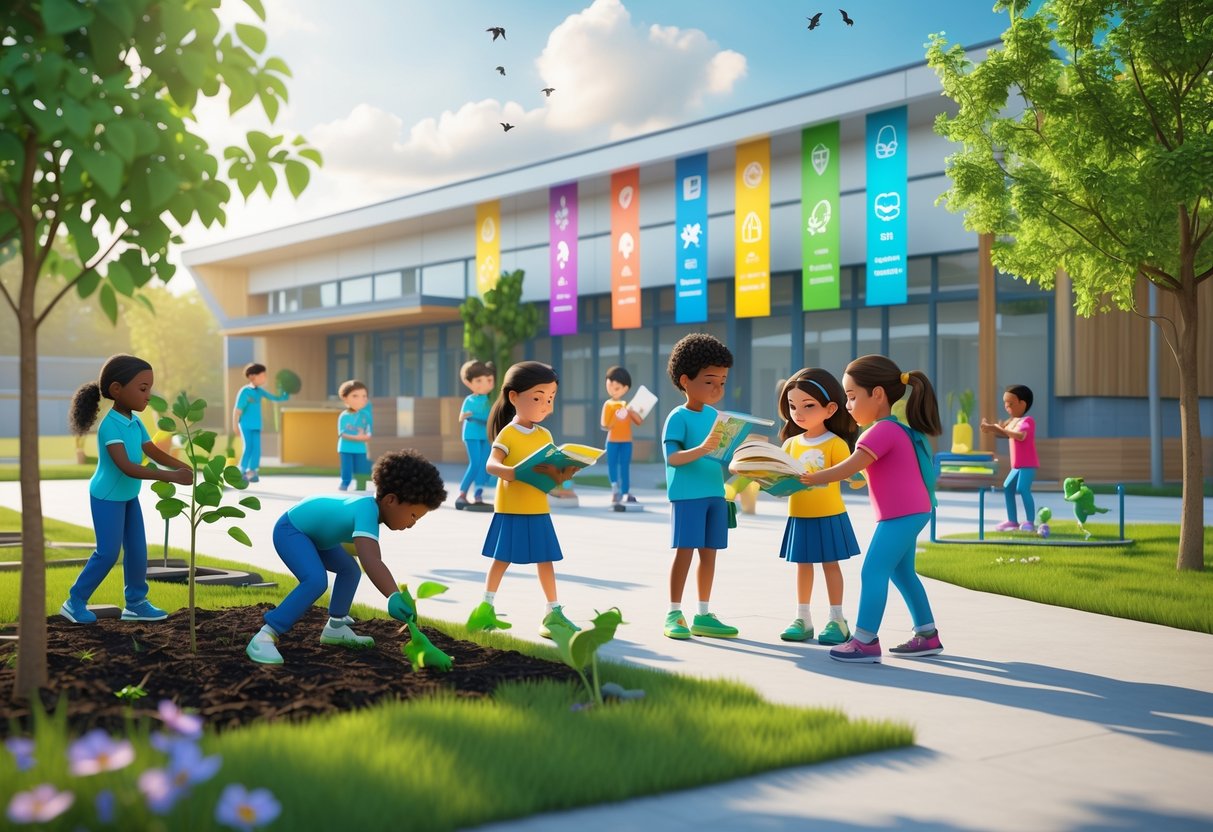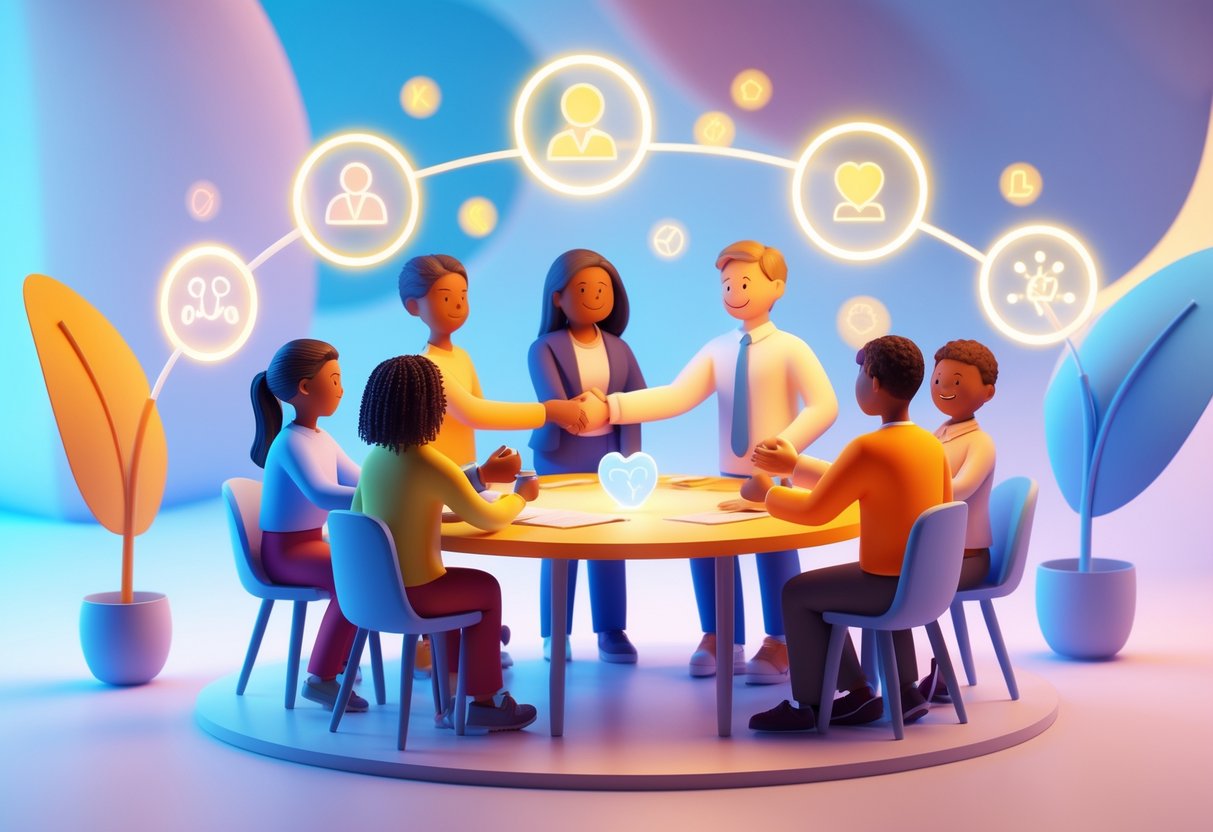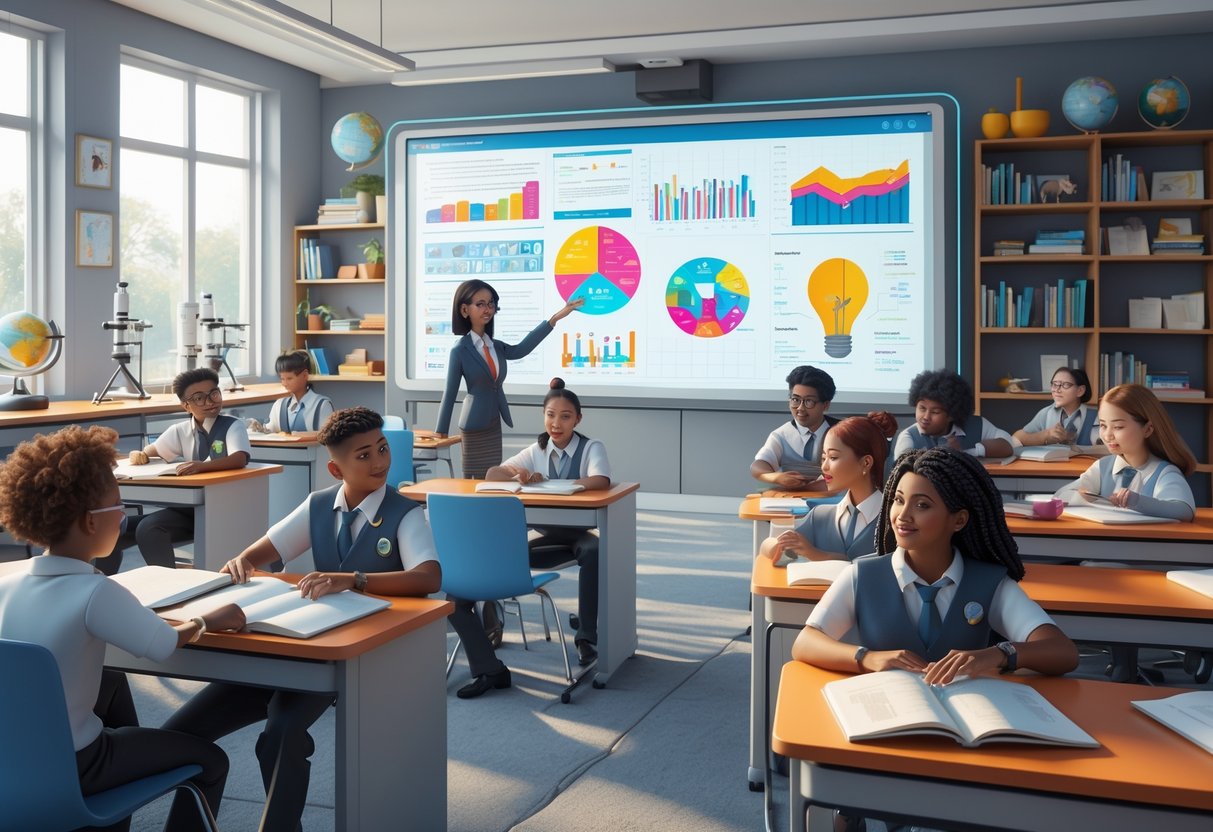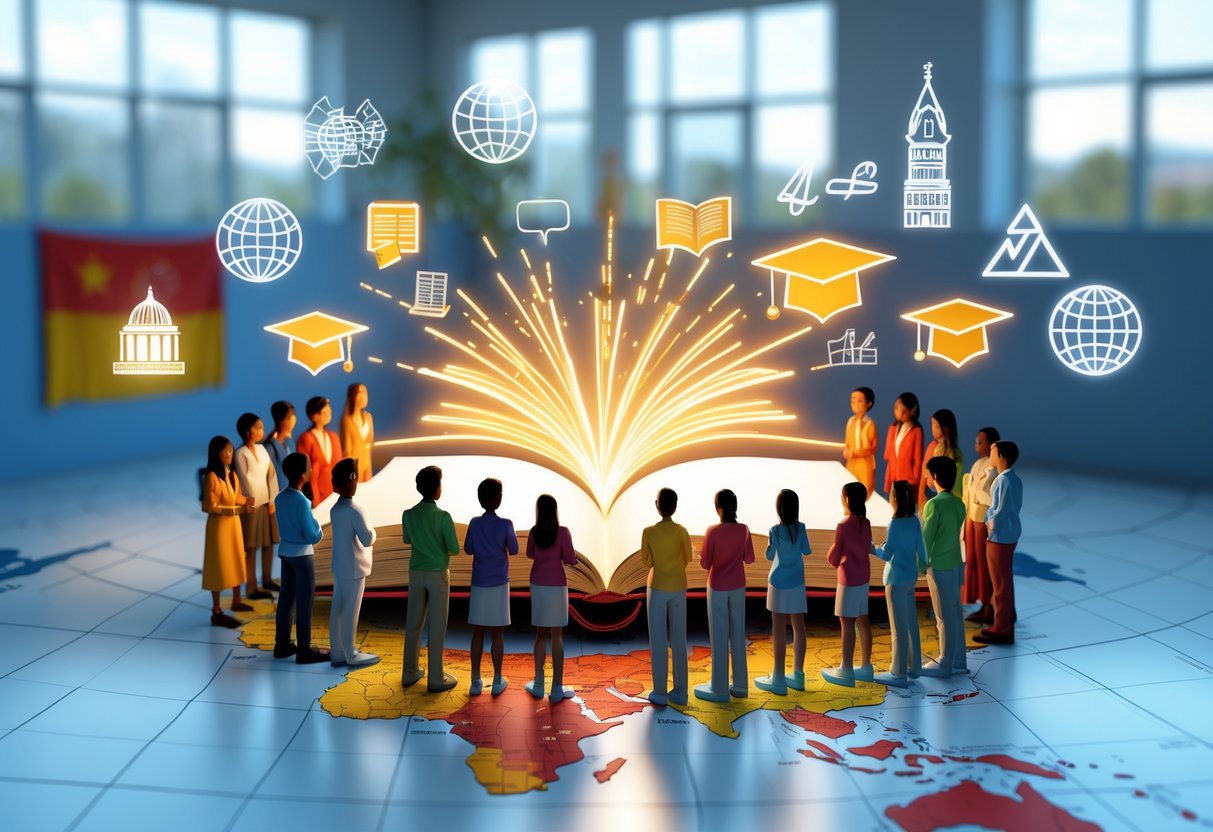Educational Value: Key Concepts, Impact, and Best Practices
Updated On: October 23, 2025 by Aaron Connolly
Defining Educational Value
Educational value means the real benefits and positive results that learning brings to students, schools, and society. It includes the immediate skills we pick up and the long-term character growth that shapes us into responsible people.
Core Principles and Concepts
Educational value shows up in activities that spark genuine learning and personal growth. You’ll notice it when students build critical thinking, moral reasoning, and hands-on skills they can use in real life.
It involves both intrinsic value—learning just because it matters—and instrumental value, where learning helps us reach other goals. Reading literature, for example, can expand our understanding of people, but it also sharpens communication for future jobs.
Unlike just passing on facts, educational value comes from active involvement. Students connect what they learn to what they already know, making lessons stick well after exams are over.
We look at educational value in many ways. Academic achievement is part of it, but so are social skills, ethical growth, and teamwork.
Key components of educational value:
- Critical thinking development
- Character formation
- Practical skill application
- Social responsibility
- Cultural awareness
Significance Within Schooling
Schools really drive educational value by offering structure and steady support. The formal system gives every student a shot at basic knowledge and values.
Curriculum design matters a lot. Schools that blend academics with character lessons—like honesty, respect, and responsibility—help students grow in more ways than one.
The classroom itself adds value. Teachers who model good behavior and encourage open talk help students pick up empathy and communication. Sometimes, those soft skills end up more useful than grades.
Assessment methods that capture educational value:
- Portfolio-based evaluations
- Peer collaboration projects
- Community service requirements
- Leadership opportunities
- Problem-solving scenarios
School rules and routines set clear expectations. When students see fairness and understand consequences, they start to learn about justice and accountability in a way that sticks.
Role in Lifelong Learning
Educational value doesn’t stop at graduation—it follows us through life. The habits and thinking skills we pick up in school shape how we handle challenges at work and at home.
Workplaces offer professional development that lets employees keep up with changing industries. These chances build on what we learned in school and help us grow new skills.
Informal learning counts too. Community programs, volunteering, and self-guided study all help us keep growing. Staying curious and open to new ideas really makes the difference.
Lifelong learning applications:
- Career advancement through continuous skill development
- Civic participation informed by critical thinking
- Personal relationships enriched by empathy and communication
- Cultural engagement broadened by diverse perspectives
Values we learn early on build a base for ethical choices later. When we hit tough spots in life, our character training from school helps us figure out what to do.
Fundamental Educational Values
Three big pillars hold up meaningful education: strong character, academic knowledge, and personal growth. These shape how we learn, interact, and become responsible people.
Integrity and Honesty
Integrity and honesty sit at the heart of real learning. When schools nurture these moral values, students feel safe to ask questions and admit mistakes.
Students learn best when they don’t have to pretend they understand. Admitting confusion is actually valued.
Key practices include:
- Encouraging honest self-reflection in assignments
- Modelling transparent communication as educators
- Addressing cheating through teaching rather than punishment
- Celebrating intellectual courage over perfect answers
We see integrity when students cite sources, admit when they’re stuck, and own their learning path. These habits go way beyond school.
Teachers who show honesty about their own learning set a strong example. When we admit mistakes and show how we bounce back, students get more resilient and real.
Respect and Compassion
Respect and compassion turn classrooms into communities where everyone gets heard. These educational values build relationships grounded in mutual understanding.
We teach respect by having students listen to each other’s perspectives. Dialogue, even disagreement, becomes part of learning.
Practical approaches include:
- Using restorative practices instead of punitive discipline
- Teaching conflict resolution skills explicitly
- Celebrating diverse cultural backgrounds and experiences
- Encouraging peer support and collaboration
Compassion grows when students see that everyone has struggles. Storytelling, community service, and solving real-world problems bring empathy to life.
Schools that focus on these values usually see more engaged students and fewer behavior issues. Students feel cared for, not just managed.
Inclusion and Justice
Inclusion and justice make sure every student gets a fair shot at meaningful learning. True learning happens when all students feel seen and valued.
Justice in education means breaking down barriers that hold some students back. That might mean helping with learning differences, money troubles, or cultural gaps.
We create inclusive classrooms by:
- Adapting teaching methods to different learning styles
- Using diverse examples and perspectives in curriculum
- Addressing bias in assessment and discipline practices
- Ensuring physical and emotional accessibility
Inclusion isn’t just about being in the room. It’s about designing learning so every student can bring their strengths and ideas.
When we use these ideas every day, we help students get ready for a diverse world and build their leadership skills.
Moral and Ethical Principles in Education
Schools need to teach more than just facts—they need to build character. Strong moral values help students make better choices in and out of school.
Importance of Moral Education
Moral education shapes how students decide right from wrong. It’s not just about rules. It helps them understand why actions matter.
Schools get the best results when they weave moral values into daily lessons. In history, students might discuss tough choices leaders faced. In science, they might debate the ethics of new technology.
Teachers set the tone by modeling respect and fairness. Students notice how teachers treat others and how they handle mistakes.
Value education sticks when it connects to real life. Students see how honesty builds trust and why fairness matters in group work.
Research shows students with strong moral foundations tend to do better. They work harder, treat others kindly, and stand up against bullying.
The goal isn’t perfect students. It’s helping young people think through tough situations so they’re ready when life gets complicated.
Upholding Accountability and Truth
Accountability means students own their actions—both good and bad. Schools that focus on this see real changes in behavior.
Clear expectations show students what accountability looks like. They follow rules better when they know what’s expected. When they slip up, they learn to accept the consequences.
Truth is the backbone of all learning. Students should value honest answers, even when they’re hard. That starts with things like citing sources and grows into a commitment to academic integrity.
Teachers can show accountability by admitting when they don’t know something. Saying, “I don’t know, but let’s find out,” builds trust.
Peer feedback helps too. When classmates review each other’s work, everyone learns to give honest, useful comments. Constructive criticism helps everyone improve.
Schools can celebrate accountability by recognizing students who do the right thing, like returning lost items or owning up to mistakes.
Fostering Courage and Perseverance
Courage in school isn’t just about bravery. It’s speaking up for what’s right and trying new things, even when it feels risky. Students need safe places to practice being brave.
We encourage students to take risks, like presenting to the class or tackling tough math problems. When failure is seen as part of learning, kids are more willing to try.
Perseverance means pushing through when things get tough. Struggling doesn’t mean you’re not smart—it means you’re growing. This mindset helps students handle harder challenges later.
Stories about real people who showed courage and perseverance can inspire students. Whether it’s scientists who failed many times or activists fighting for justice, these stories stick.
Teachers can help by breaking big tasks into smaller steps. Students feel more confident as they see progress. Every small win builds their willingness to keep going.
Group projects teach these values too. Students support each other and learn that teamwork often beats giving up.
Educational Value in the Curriculum
Educational value comes alive when it’s built into daily lessons. Teachers can weave these values into every subject and use teaching methods that help students think and solve problems.
Integration Into Subjects
We don’t need a special “values” class to teach life skills. Values work best when they’re part of regular lessons.
In math, students learn honesty by showing their work and persistence by sticking with tough problems. Science sparks curiosity and respect for facts.
History builds empathy as students learn about other cultures. They also practice critical thinking by looking at sources and evidence.
English is great for exploring values. Students read stories about kindness, courage, and justice. They learn to share their own ideas clearly and respectfully.
Art and music help students appreciate beauty and creativity. PE teaches teamwork and fair play. Even simple group projects build cooperation.
The best part? Students pick up these values naturally while learning what they need for school.
Developing Critical Thinking
Critical thinking teaches students to question what they see and hear. It helps protect them from bad information and poor choices.
We teach students to ask questions like, “Who said this?” and “What evidence backs this up?” They learn to tell facts from opinions.
Students look at problems from different angles. They realize tough issues rarely have just one answer, so they avoid snap judgments.
Debates are great for building these skills. Students research, consider other viewpoints, and learn to argue their case. They also practice listening with respect.
We encourage students to check their sources and figure out which ones to trust. That’s huge in a world full of information.
Group discussions let students share ideas and challenge each other’s thinking. Changing your mind after learning something new? That’s not a weakness—it’s a sign you’re really thinking.
Scientific and Humanities Approaches
Science classes teach values by letting students get hands-on. They follow clear steps and record their results honestly.
Good science takes patience and accuracy. You can’t really rush it or cut corners.
Lab work pushes students to share equipment and bounce ideas off each other. When experiments flop, they have to keep going and figure out what went wrong.
Mistakes, honestly, often teach more than quick successes ever could.
History and geography classes open students up to different viewpoints. They explore human rights and social justice through real stories from the past and present.
Science sharpens logical thinking. Humanities invite students to understand people and whole societies.
Literature lets students wrestle with moral choices through characters and stories. They get to talk about right and wrong in a space that feels safe.
Field trips and guest speakers help connect classroom learning to the real world. Students watch how values from school play out in actual workplaces and communities.
Research projects pull both approaches together. Students collect data like scientists but also think about human impacts as historians or geographers.
Social Responsibility and School Values

Teaching social responsibility helps students see their place in making positive changes. Schools build these values through hands-on activities and real chances to get involved.
Promoting Community Engagement
Community engagement shows students the world outside school. When schools involve them in local projects, students realize their actions matter.
They might join neighbourhood clean-ups or visit elderly care homes. These experiences put them face-to-face with real community needs.
Effective community engagement includes:
- Local charity partnerships
- Environmental projects
- Cultural exchange programmes
- Mentoring younger students
Schools should give students regular chances to work with local groups. This helps build lasting ties between students and their communities.
Many schools work with food banks or animal shelters. Students learn about social issues while actually helping out.
Building Social Responsibility
Social responsibility means thinking about how our choices affect others. Teachers can build this through classroom rules and school-wide policies.
Students learn responsibility when they help set class agreements. It gives them a sense of ownership over their behaviour and learning space.
Key ways to build responsibility:
- Student-led initiatives
- Peer mediation programmes
- Environmental awareness projects
- Leadership opportunities
When students run recycling drives or mental health campaigns, they pick up real leadership skills. They see firsthand that anyone can make a difference.
Teachers need to model responsible behaviour every day. Students notice what adults do much more than what they say.
Encouraging Service and Participation
Service learning ties classroom lessons to real-world problems. Students get to use what they know while helping out in their communities.
Volunteering regularly teaches students that service is just part of life. Schools should make sure every student can join in, no matter their background.
Successful service programmes include:
- Weekly volunteer commitments
- Skills-based projects
- Cross-age tutoring
- Community research projects
Students might tutor younger kids in maths or build websites for local charities. These activities build confidence and help others at the same time.
Schools can track service hours and celebrate what students contribute. That recognition often inspires more students to join in.
The best service projects tackle real problems students care about. When they care, motivation and learning come naturally.
Interpersonal Values and Relationships

Strong relationships built on respect and trust make education meaningful. These connections teach us life skills—kindness, cooperation, and true appreciation for others.
Friendship and Kindness
Friendships at school show us how to care for others. When we build real connections with classmates or teammates, empathy comes naturally.
Kindness isn’t just about being polite. It’s about helping others succeed, even when there’s nothing in it for you.
You might:
- Help a struggling teammate learn new strategies
- Share resources without expecting anything back
- Stand up for others when they’re criticized
These actions build trust between people. Trust makes it easier to take risks and try new things.
Teachers who show kindness usually see students open up more. Students feel safer asking questions if they know their teacher cares about their success.
The same thing pops up in gaming and esports teams. Players who support each other usually handle pressure better.
Harmony and Cooperation
Working well with others takes balance and shared goals. We learn to put the group ahead of our own recognition sometimes.
Cooperation means finding solutions that work for everyone. In group projects, this might mean dividing tasks based on who’s good at what—not just splitting things evenly.
Effective cooperation includes:
- Listening to different viewpoints
- Making decisions together
- Resolving conflicts calmly
- Celebrating group wins
Harmony isn’t about avoiding disagreements. It’s about handling them with respect. We can disagree with ideas and still respect the person sharing them.
Teams that find harmony often outperform groups with more individual talent. You see it in study groups, sports teams, and at work.
Sharing and Appreciation
Sharing knowledge and resources lifts everyone up. When we teach others what we know, the whole group gets stronger.
Real sharing goes further than just giving things away. It means:
- Teaching skills we’ve learned
- Acknowledging others’ work openly
- Giving credit where it’s due
- Creating chances for others to shine
Appreciation means noticing the value others bring. We see different talents and perspectives that make our team better.
This creates a positive cycle. When people feel appreciated, they give more. When they give more, everyone grows.
Students who share what they know often end up understanding subjects better themselves. Teaching others really locks in your own learning.
Personal Growth and Individualism

Education shapes us as individuals and helps us build the skills we need to work with others. We find excellence when we work to improve ourselves and balance personal goals with team success.
Fostering Excellence
Excellence starts with knowing our own strengths and interests. We all learn differently and shine in different areas.
Some students learn best with visuals. Others need hands-on experience or deep discussions.
The best schools adapt to these differences. They offer more than just one way to succeed.
We can encourage excellence by:
- Spotting our talents early
- Setting goals that challenge us but aren’t impossible
- Asking for feedback often
- Celebrating progress, not just results
Values shape how we learn. Students who care about achievement set clear goals. Others who value understanding dig deeper into subjects.
When our education matches what matters to us, we naturally do better.
Commitment to Self-Improvement
Self-improvement starts with honest reflection. We need to look at our strengths and weaknesses and be willing to challenge ourselves.
Educational self-reflection helps us understand our beliefs and values. This awareness guides our personal development journey.
A lot of students keep a learning journal. It helps to track what’s working, what’s not, and how we’re growing.
Improvement means:
- Treating mistakes as learning chances
- Trying new, tough experiences
- Asking for help when we need it
- Staying curious
Lifelong learning doesn’t end with school. We grow through work, hobbies, and relationships all our lives.
The habit of constant improvement keeps us adaptable and interested in the world.
Balancing Individualism and Teamwork
Strong individuals make strong teams. We need confidence and skills to really contribute.
Individual growth means building self-awareness, thinking critically, and taking responsibility. These skills help us work better with others.
If we focus too much on ourselves, it can hurt the team. We have to learn when to lead and when to follow.
Balance looks like:
- Bringing our strengths to group projects
- Listening to other perspectives
- Supporting teammates’ growth
- Owning both personal and group results
Character education teaches values like empathy, cooperation, and social responsibility. These round out academic skills.
We do best when we can think for ourselves and still work well with others. That’s what prepares us for modern jobs and communities.
Leadership and Open-Mindedness

Strong leaders in esports teams and organisations know how to guide others and stay open to new ideas. This mix helps teams adapt, try new strategies, and create inclusive environments where everyone can contribute.
Encouraging Leadership Qualities
Leadership shows up when players and coaches balance confidence with humility. Good esports leaders make clear calls in tense moments, but they also know when to let teammates lead.
Key leadership behaviours in gaming:
- Clear communication – Calling plays without shouting over everyone
- Quick adaptation – Switching strategies on the fly
- Team focus – Putting the group’s win over personal stats
- Constructive feedback – Helping teammates improve without crushing their confidence
Some teams even rotate leadership roles depending on the situation. Maybe the support player calls objectives while the carry handles mechanics. This works because different people bring different strengths.
The best captains ask questions instead of barking orders. They’ll say, “What do you think about rotating top?” rather than, “Everyone rotate top now.” It gets everyone thinking.
Embracing Open-Mindedness
Open-mindedness turns good players into great leaders. Top teams always question their own assumptions. They try new comps in scrims and review losses without making excuses.
How leaders show open-mindedness:
- Reviewing replays to learn from mistakes
- Trying out strategies from newer teammates
- Studying opponents to pick up new ideas
- Adjusting coaching for different personalities
Aaron Connolly, a gaming journalist, once said: “The best esports leaders I’ve met get excited when someone proves them wrong. It means they’re about to learn something new.”
This attitude keeps teams from getting stale. When leaders welcome new ideas, they find strategies that surprise their opponents. You see it in teams that upset higher-ranked rivals with creative play.
Valuing Diversity and Inclusion
Inclusive leadership makes teams stronger by drawing from different backgrounds and ways of thinking. Diverse teams often come up with more creative solutions.
Building inclusive teams:
| Challenge | Inclusive Approach | Result |
|---|---|---|
| Language barriers | Use simple callouts, visual aids | Better communication |
| Different skill levels | Pair experienced with newer players | Faster improvement |
| Varied gaming backgrounds | Learn from different game experiences | More tactical options |
| Cultural differences | Respect different practice schedules | Better team cohesion |
Smart leaders ask for input from everyone, not just the loudest voices. They encourage quieter players or those with different gaming backgrounds to share ideas.
Inclusive teams usually handle tournament pressure better. When everyone feels valued, they’re more likely to speak up with important info. This means fewer communication breakdowns and smoother teamwork.
The best teams mix structure with flexibility. Leaders set clear roles but stay open to everyone’s input. That’s how teams stay consistent and ready for anything.
Educational Value in Formal Education

Formal education creates value by offering structured learning and community-based experiences. Schools build foundational knowledge while encouraging critical thinking that goes way beyond textbooks.
Role of Formal Schooling
Formal schooling gives students a structured way to pick up knowledge and skills they’ll need down the road. You can see this in the way schools follow set curricula, covering basics like maths, science, and languages.
Schools set up standardised learning pathways so every student gets a similar educational foundation. This structure pushes students to think critically and solve problems in all kinds of subjects.
Key benefits of formal schooling include:
- Structured progression through educational levels
- Access to qualified teachers and resources
- Standardised assessment methods
- Recognition through certificates and qualifications
The education system teaches students how to work within established frameworks. They learn to manage time, stick to schedules, and meet deadlines—skills that stick with them in the workplace.
But it’s not just about academics. School also builds social skills through peer interaction. Students pick up collaboration, communication, and conflict resolution during group projects and everyday chats.
Value Education Versus Traditional Approaches
Value education aims for character development alongside good grades. It’s a different vibe from traditional methods, which mostly focus on passing on knowledge and acing tests.
Traditional approaches typically involve:
- Teacher-centred instruction
- Memorisation-based learning
- Individual competition
- Standardised testing focus
Value education emphasises:
- Student participation in moral reasoning
- Collaborative learning experiences
- Character development activities
- Real-world application of ethics
Value education helps students develop empathy and social responsibility. They get involved in community service and learn about cultural diversity through hands-on experiences.
This approach encourages students to think critically about moral dilemmas. They discuss ethical scenarios and learn how to make decisions based on shared values.
Building a Supportive School Community
Strong school communities grow when everyone—teachers, students, parents, and administrators—works together for common goals. That’s when educational value really thrives.
Effective school communities feature:
- Open communication between all stakeholders
- Shared decision-making processes
- Regular community events and activities
- Mutual respect and trust
Parents make a huge difference by getting involved. When families volunteer or help with academics, students tend to do better.
Teachers play their part by creating inclusive classrooms. They set clear expectations and offer emotional support when students need it.
Student leadership opportunities also matter. Peer mentoring and student councils give learners a chance to take responsibility and help others.
Community partnerships connect schools with local organisations. These relationships offer real-world learning and help students see their place in society.
Approaches to Teaching Educational Values

Teachers need practical ways to help students build strong values. That might happen through direct teaching, everyday classroom moments, or even how they assess students. The best value education mixes explicit strategies with real-world application and time for reflection.
Classroom Strategies and Programmes
We can bring values education into classrooms using five main approaches. The inculcation approach has teachers directly teaching values like honesty and responsibility, expecting students to take them on board.
The moral development approach uses stories and scenarios. Students talk through dilemmas, weighing different options and sharing their reasoning.
Values analysis pushes students to think logically about social issues. They research, gather facts, and reason through what’s right or wrong.
Values clarification lets students explore their own beliefs. Activities like ranking exercises and personal reflection help them figure out what really matters to them.
The action learning approach goes further. Students spot problems in their school or community and actually do something about them—maybe a charity drive or a recycling project.
Integrating Values Into Everyday Learning
Values education works best when it’s part of everyday lessons, not just a separate subject. We can teach respect and cooperation during group science experiments, or talk about fairness when studying history.
Role modelling is huge. Teachers show values like patience, kindness, and curiosity just by how they treat students. When we respect different viewpoints in class, students pick up on that.
Classroom routines give students constant chances to practice values. Taking turns, helping out, and caring for shared materials all reinforce positive habits. Setting clear expectations helps students treat each other well and take responsibility.
Cross-curricular connections make values feel real in every subject. Literature classes dig into character motivations, maths can touch on fairness, and art can celebrate diversity.
Schools benefit when everyone—from teachers to staff—reinforces the same core values.
Assessment and Reflection on Values
Assessing values is different from grading tests. We watch how students behave during group work, conflicts, and daily routines to see if they’re putting values into action.
Portfolio assessment lets students collect evidence of their growth. They might include reflections on tough choices, photos from service projects, or peer feedback.
Self-reflection activities get students thinking about their own progress. Journals, goal-setting, and honest discussions all help.
Peer assessment gives students feedback about how their actions affect others. Activities where classmates share positive observations can be eye-opening.
Action-based assessment focuses on what students do, not just what they say. We notice if they help others, stand up for classmates, or make ethical choices on their own.
The best assessments mix these approaches and focus on growth, not perfection. Developing strong values takes time and practice.
Cultural Influences on Educational Value

Culture shapes how we see education and what we value most in learning. Different backgrounds bring unique ideas about teaching, while global awareness pushes everyone toward shared values like sustainability.
Role of Cultural Backgrounds
Cultural backgrounds shape what families and communities expect from education. These expectations influence how students learn and what they care about.
Family expectations can be all over the map. Some families put academic achievement first, while others value creativity or personal growth.
Learning styles differ too. Some cultures lean toward group learning, while others prefer solo study and competition.
Communication patterns in class often reflect cultural norms. Students from certain backgrounds might not speak up much, but that doesn’t mean they’re not paying attention—it’s just a different way of showing respect.
Parents and communities reinforce educational values. When schools work with families from diverse backgrounds, they build stronger learning environments and bridge cultural gaps.
Sustainability and Global Perspectives
Education now puts more focus on sustainability and global awareness. These values reflect how connected the world has become.
Environmental consciousness shapes what gets taught. Schools cover topics like climate change, renewable energy, and conservation, hoping to create citizens who think long-term.
Global citizenship is on the rise. Students learn about other cultures, international cooperation, and shared values. It helps them look beyond their own communities.
Cross-cultural understanding grows through exchange programmes and diverse discussions. Students develop empathy and learn that there’s more than one way to solve problems.
These global perspectives help students balance local traditions with universal needs.
Challenges and Future Directions

Education systems feel the pressure to keep up with rapid changes and new tech. The real challenge? Holding onto core values while adapting to what’s coming next.
Adapting to Societal Changes
Global conflicts, economic shifts, and new workforce demands force us to rethink which values in education really matter. Traditional models have a hard time dealing with structural inequalities and meeting diverse student needs.
The education system needs to teach cultural awareness and cooperation as the world gets more connected. Students need skills for jobs that haven’t even been invented yet.
Community engagement matters more than ever. Schools now partner with local organisations to tackle real problems, helping students see how their learning fits into society.
Key adaptations needed:
- Flexible curricula that respond to local needs
- Diverse teaching methods for different learning styles
- Strong links between schools and communities
- Focus on critical thinking over memorisation
Schools can’t work in isolation anymore. They need to engage with families, employers, and the wider community to stay relevant.
Technological Impact on Values
Digital tools are changing how we learn and connect. We’re all asking questions about screen time, AI, and what counts as real assessment.
Technology makes personalised learning possible, but it also risks leaving some students behind if they don’t have access.
Balancing act required:
- Human interaction vs automated learning
- Digital skills vs traditional literacy
- Innovation vs proven methods
- Efficiency vs deep understanding
We have to teach students to use technology wisely, not let it run their lives. Digital citizenship and ethical reasoning are more important than ever.
Empathy and collaboration still matter—maybe even more now. Technology should lift up these human qualities, not replace them.
Envisioning Future Educational Values
By 2030, education will probably focus on sustainability, adaptability, and global citizenship. We’re moving toward learning that prepares students for a world that’s anything but certain.
Emerging value priorities:
| Traditional Focus | Future Focus |
|---|---|
| Individual achievement | Collaborative problem-solving |
| Subject separation | Interdisciplinary thinking |
| Local perspective | Global awareness |
| Fixed curriculum | Adaptive learning |
Environmental education is becoming a must-have. Students need to know how they fit into creating a sustainable future.
Project-based learning is on the rise. Students work on real challenges, building confidence and seeing the practical side of education.
Values gaining importance:
- Resilience and mental wellbeing
- Creative problem-solving
- Cultural competence
- Lifelong learning mindset
The goal is shifting. We’re not just producing workers—we’re developing thoughtful citizens who can handle complexity and make a positive difference.
Frequently Asked Questions

People have plenty of questions about how education actually creates value. These range from classroom examples to moral development and the bigger social impact.
What examples can illustrate the concept of educational value in a classroom setting?
Science experiments show educational value by teaching students to observe, hypothesise, and test ideas. For example, when students grow plants under different lights, they learn the scientific method and build patience.
Group projects highlight value through teamwork and communication. Students split up tasks, work through disagreements, and present together.
Reading comprehension exercises build critical thinking. Analysing character motivations and plot twists helps students strengthen reasoning skills for real life.
Can you suggest some synonyms for ‘educational value’ that capture the same essence?
Learning benefit points to the advantage students get from their education. Academic worth highlights the importance of what’s being taught.
Teaching merit describes what makes instruction valuable. Instructional significance focuses on the impact of educational experiences.
Pedagogical value looks at the methods that drive learning. Educational impact talks about the lasting effects on students’ growth.
Could you list ten values that education typically imparts on students?
Responsibility grows through homework and classroom duties. Perseverance develops as students tackle tough maths or long projects.
Respect comes from working with different classmates and teachers. Honesty matters for academic integrity and open communication.
Curiosity expands as students explore new topics and ask questions. Empathy grows during literature discussions and by seeing other perspectives.
Critical thinking gets stronger when students analyse evidence. Cooperation improves during team activities.
Self-discipline shows up in study habits and following rules. Fairness develops on the playground and in classroom talks about justice.
How do social values shape the approach to education in various societies?
Collectivist societies focus on group harmony and teamwork. Students often work in teams and learn to put the group first.
Individualist cultures encourage personal achievement and independent thinking. Students are pushed to share unique ideas and compete for recognition.
Religious values shape curriculum and teaching styles in many places. Some schools blend spiritual teachings with academics, while others keep them separate.
Economic priorities also matter. Societies with big manufacturing sectors usually push technical education and apprenticeships.
In what ways does education contribute to the development of an individual’s moral values?
Literature classes throw students into moral dilemmas through character studies and ethical conflicts. They talk about right and wrong while analyzing stories that honestly feel a lot like real-life situations.
History lessons dig into the consequences of moral choices made by both individuals and entire societies. Students get a chance to see how ethical decisions can shape what happens next.
Classroom rules give students a real shot at practicing fairness and respect every day. They notice how treating others well—and sticking to the rules—actually pays off.
Community service projects tie moral values to real-world action. When students help out, they see firsthand how their efforts can make a real difference in their neighborhoods.
What role does the educational value play in the overall development of a child?
Educational value lays down the groundwork for lifelong learning. Kids pick up crucial skills like reading comprehension, mathematical reasoning, and scientific thinking.
In classrooms, children connect with peers and teachers. Through these interactions, they figure out how to communicate, solve disagreements, and work together toward common goals.
When kids face academic challenges, they start to grow emotionally. They build confidence and learn resilience by pushing through tough spots.
Structured learning environments get kids ready for adult life. Here, they practice managing their time, setting goals, and solving problems—skills that really stick with them.

